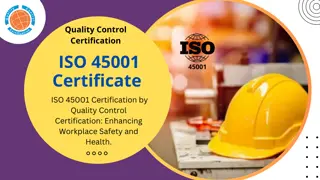The Impact of ISO Standards on Corporate Innovation
Discussion among corporate leaders on the relevance of ISO standards for innovation management, initial skepticism, evolution to curiosity and appreciation, and considerations for implementation in organizations.
Download Presentation

Please find below an Image/Link to download the presentation.
The content on the website is provided AS IS for your information and personal use only. It may not be sold, licensed, or shared on other websites without obtaining consent from the author.If you encounter any issues during the download, it is possible that the publisher has removed the file from their server.
You are allowed to download the files provided on this website for personal or commercial use, subject to the condition that they are used lawfully. All files are the property of their respective owners.
The content on the website is provided AS IS for your information and personal use only. It may not be sold, licensed, or shared on other websites without obtaining consent from the author.
E N D
Presentation Transcript
Do Corporate Innovators Need ISO Standards? Highlights from an August 2024 Discussion Among Corporate Leaders
About the ISO 56000 Standards for Innovation Management ISO 56001 is the requirements standard (the one you can be certified against), and there are 10 other standards in the works, or published, that are intended to serve as guidance. We shared two of the shorter standards docs with our discussion participants ISO 56002, guidance on innovation management systems, and ISO 56004, guidance on innovation management assessments.
Members of our ISO standards reading group Robyn Bolton, Founder of the consulting firm MileZero, and previously a partner at Innosight Jodie Brinkerhoff, VP of Innovation at Dallas-Fort Worth Airport Michael Cross, most recently VP of Innovation at the utility Entergy, and previously a VP at CSAA Insurance Navin Kunde, Innovation Leader at the engineering and construction firm Black & Veatch Ben Little, Director of the Design Innovation program at MassArt, and an executive working in financial services John Parello, Principal Engineer at Cisco Innovation Labs
Had you heard of the ISO standards previously? If so, what was your impression of them? Initial reactions varied: "We don't need no stinkin' standards!" Skepticism: Many believed ISO standards for innovation were unnecessary or too rigid. Some were vaguely aware, while others had not engaged deeply with them. Many saw it as an attempt to over-systematize a creative process.
How did that change after reading the standards? Shift from skepticism to curiosity and appreciation. Realization of potential benefits: standardization could bring legitimacy and consistency. Some felt the standards could professionalize the field of innovation management. Mixed feelings: Some still found the standards overly prescriptive or lacking flexibility. Others noted that they could help protect the work of innovation teams when leadership changes.
Could you envision applying these in your organization? Yes especially in more traditional or mature organizations. Provides structure and a roadmap, particularly for new innovation teams. Concerns remain: Too complex or not adaptable enough for smaller, more agile organizations. Could be used selectively: adopting useful parts and discarding the rest. Some saw the standards as a useful tool for aligning innovation with corporate goals.
What benefits would they have? Standardization helps professionalize the field of innovation management. Can align innovation efforts with other standardized corporate processes. A useful tool for building and scaling innovation teams, particularly in larger organizations. Can provide a stable framework that survives leadership changes. Helps in creating a common language and understanding across teams.
Drawbacks? Complexity: The standards may be overwhelming for newcomers to innovation, and newly-formed team. Too rigid: May not suit more dynamic, fast-paced innovation environments. Not a one-size-fits-all solution: Some aspects may not be applicable to every organization Risk of stifling creativity with too much structure.
Advice for other innovators who havent looked at them yet Take what works: Use the standards as guidance, not gospel. Start simple: Focus on key areas that align with your organizational goals. Context matters: Adapt the standards to fit the unique needs and culture of your organization. Don t be afraid to modify, pick and choose, or iterate. Lean on the standards for credibility, but don't let them hinder innovation.























